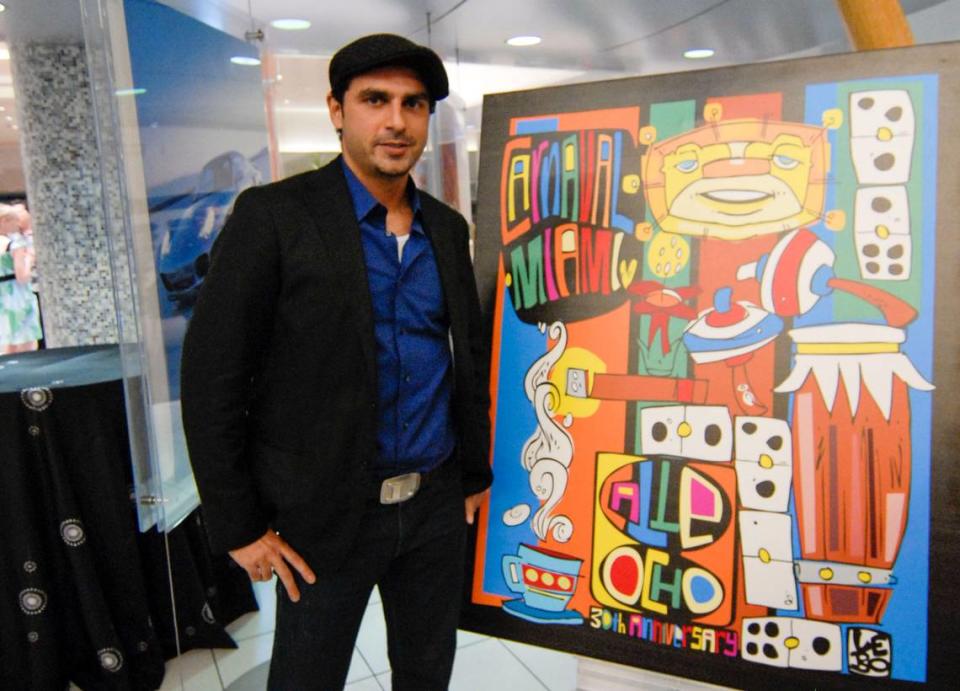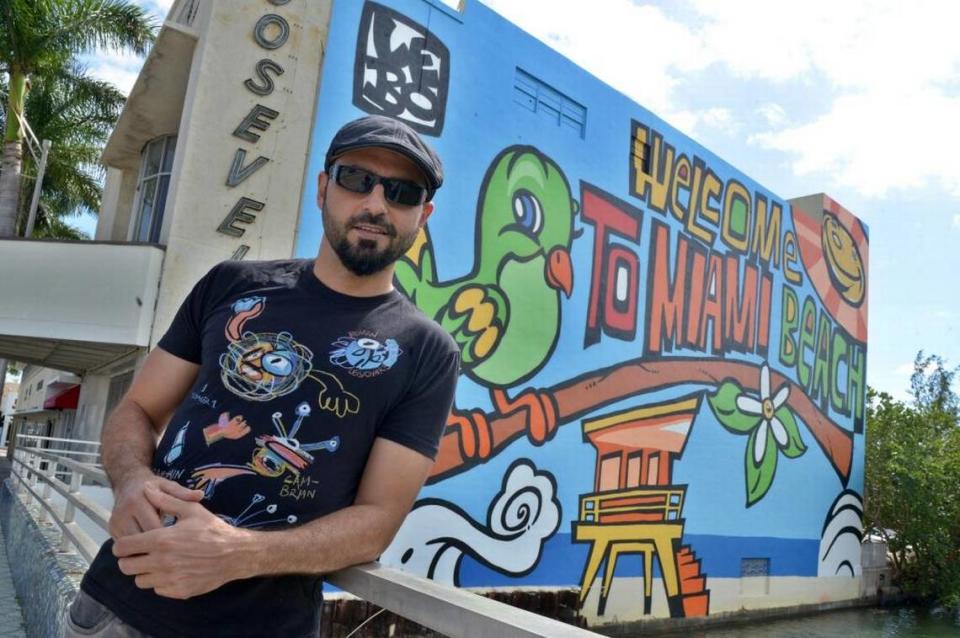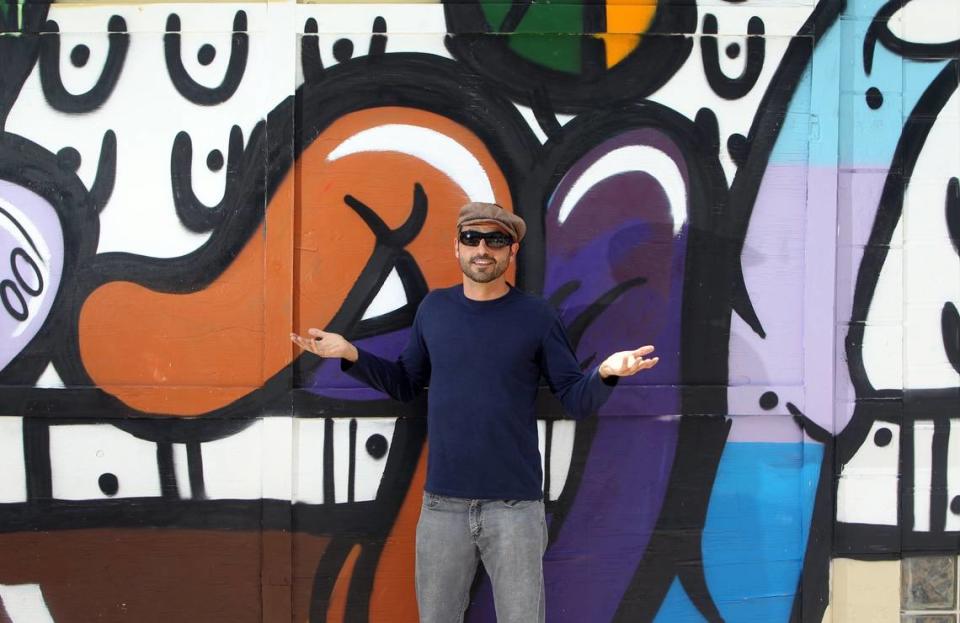Miami artist David Le Batard, known as Lebo, dies at 50, says brother Dan Le Batard
- Oops!Something went wrong.Please try again later.
- Oops!Something went wrong.Please try again later.
David Le Batard, known as the colorful Miami street artist Lebo, died early Tuesday morning at age 50, his older brother Dan Le Batard, host of the popular sports podcast The Dan Le Batard Show with Stugotz, announced.
He was diagnosed with an undisclosed illness about a year ago, his brother said. Dan Le Batard described the loss of his brother, “my best friend for over 50 years,” as “inconceivable.”
We’re Live
https://t.co/6IwClttgOL pic.twitter.com/0pIaSXllIn— Dan Le Batard Show with Stugotz (@LeBatardShow) August 1, 2023
“I don’t have a lot of experience with grief, but I had been grieving him for a year,” he said during his podcast. “Because when he was diagnosed more than a year ago, he’s been steadily deteriorating since. And it’s been brutally, brutally hard to watch a poison eat him up from the inside and one of the biggest spirits I’ve ever seen consumed by illness.”
David Le Batard, known for his murals and artworks that often featured adorable cartoon birds, was a well-respected artist who rose to prominence in his 20s. He was a fixture in South Florida who perfected an immediately recognizable artistic style. He proudly called himself a cartoonist and described his artwork as “Postmodern Cartoon Expressionism,” combining cartoon imagery, saturated colors and thick black lines.

His murals brighten buildings in Miami Beach, Coconut Grove, Hollywood, Fort Lauderdale, Pembroke Pines and beyond. In 1998, when he was 25, he returned to his elementary school, St. Bartholomew Catholic School in Miramar, to paint a mural of a diverse group of cartoon children dancing in flowers. The kids loved it.
His art is featured in private collections around the world, and he has worked with several brands, including Lulu Lemon, Harley Davidson, Audi, Google, Microsoft, Redbull, Ketel One, Bacardi, and Ferrari. One of his most ambitious projects was designing the hull of a Norwegian Cruise Lines ship with a swimming mermaid.
Perhaps his most well-known mural greets Miami Beach residents and tourists as they cross a small bridge on 41st Street. On the side of the abandoned Roosevelt Theater, a smiling green monk parakeet sits on a branch over an orange lifeguard stand and a calm blue ocean. “Welcome to Miami Beach” is emblazoned in bold letters underneath a happy cartoon sun. Completed in 2016, it was the largest mural approved by the city of Miami Beach, according to the artist’s website.
The mural was mildly controversial at the time, as some critics called it “childlike.” Some residents worried it would slow traffic as drivers slowed down to get a better look. Those concerns had some truth to them. To this day, people pull over and get out of their cars to take photos of the idyllic mural.
“It sets a tone that [visitors] are somewhere else, in a really special part of the world,” Le Batard told the Miami New Times in 2016. “I want people to be happy to be here.”

Le Batard was born in New York to his Cuban immigrant parents, Gonzalo and Lourdes Le Batard. His earliest memories were of cartoons. At age 6, he’d flip through Sunday comics.
“To me, each one of those panels was a whole universe to explore,” he said in a 2017 video by Park West Gallery.
When he was 13, his family moved to South Florida to be closer to his grandparents in Little Havana, according to a 2008 El Nuevo Herald profile. He grew up in Hollywood and spent his weekends drinking cafe con leche with his abuela. He attended Chaminade-Madonna High School in Hollywood and was a Broward Silver Knight winner for the arts in 1990.
This was when his artist name was born. In high school, his code name on his pager was 0837. Turn it upside down, and you got “LEBO.”
He studied art history at Florida International University and graduated in 1995. For a short time, he worked as an exhibition coordinator at the International Museum of Cartoon Art in Boca Raton.
Le Batard had a habit of proving people wrong. In an interview years after the Silver Knight award, he said that his high school wouldn’t give him a copy of the application because they “didn’t feel like I was a worthwhile candidate.”
“It showed me that power structure should be questioned at all times, because if you go around believing what other people think about you, it could undermine what your full potential is,” he told the Herald in 2000. “On the other hand, if someone believes in you, it could show you what you’re capable of.”
In 2013, after Hollywood officials complained that his jazz-inspired mural, “Bee-Bop Into Outer Space,” was “ghetto” and “too subjective”, the artist stuck by his work.
“What opinion should a politician have on color or pattern design?” he told the Huffington Post.

Like his pager nickname, comic book influence stuck with Le Batard. His greatest influence was Spy vs. Spy, a comic strip published in Mad Magazine and illustrated by Antonio Prohías. While working at the International Museum of Cartoon Art, he learned about Prohías’ story. He was exiled by Fidel Castro for his political cartoons.
Le Batard tracked down Prohías, who was retired and living in northwest Miami, the Herald reported in 1997. The two became friends, and Le Batard would sketch for him. Prohías died the following year at age 77.
“Everything I do was inspired by him,” LeBatard said. “I hope when I’m his age there are kids who look up to me the way I look up to him.”
For many, Le Batard represented a generation of Cuban-Americans born and raised far away from their homeland. Like many, Le Batard held onto his roots best he could. His paintings reflected that. In “Abuelita’s Cafe con Leche,” he painted himself as a child having breakfast at his abuela’s house. Gamecocks fight in the background and a wiener dog sniffs fried eggs and pan cubano.
Bill Teck, the editor of generation ñ magazine, a Cuban-American publication, once said Le Batard was “an artist for the generation.”
“David’s art has a sunny, rollicking quality to it, yet it’s tradition-based,” Teck said in 1997. “It speaks to us. We are the generation that jettisoned the dogma and kept all the cool stuff.”
Dan Le Batard did not respond to the Herald’s request for an interview. On X, the social media platform formally known as Twitter, his show has posted family photos of the brothers and funny video clips of David’s appearances on the show.
Unlike his older brother, David wasn’t a massive sports fan. In one segment, David, known as “the man who has never willingly attended a sporting event,” answered sports trivia questions while drawing an artwork of a lacrosse player. The show hosts and producers were shocked whenever he answered correctly, which wasn’t often.
— Dan Le Batard Show with Stugotz (@LeBatardShow) August 1, 2023
In another segment, David drew a live portrait of Dan, who had his face painted like Darth Maul from Star Wars.
“My brother’s paintings go for a lot of money,” Dan said in the video.
“You’re right, your brother’s art does go for a lot of money. In fact, I wasted his time. I had him up in my house,” co-host Jon “Stugotz” Weiner responded. “He gave me a quote on painting something on my wall, and I told him to get the hell out.” The group laughed as David continued to draw.
On Tuesday morning, despite his wife’s suggestions that he not record the podcast, Dan Le Batard said he needed to laugh. Through tears, while sitting in a studio plastered with David’s art, he spoke candidly about the last year of his brother’s life and dealing with his diagnosis.
Their family was with David in the hospital, he said. Their father whispered to him, “We’ll see you soon.”
“I’ve spent the last year saying all the things. Getting a chance to appreciate him and say goodbye and ask for forgiveness for the family stuff and pour out my heart to him,” Dan said. “And I will tell you that there was grace and freedom at two o’clock in the morning.”
Dan, who was a longtime columnist at the Miami Herald, reassured his brother that it was OK for him to go. That he was safe. That he didn’t have to be scared. And with that, he watched as his brother stopped suffering.
“Amid the horror of that, was a seismic and great beauty that I’ll forever be grateful for,” Dan said. His brother, a man whose art made Miami a brighter place, was at peace.
This story was produced with financial support from The Pérez Family Foundation, in partnership with Journalism Funding Partners, as part of an independent journalism fellowship program. The Miami Herald maintains full editorial control of this work.

